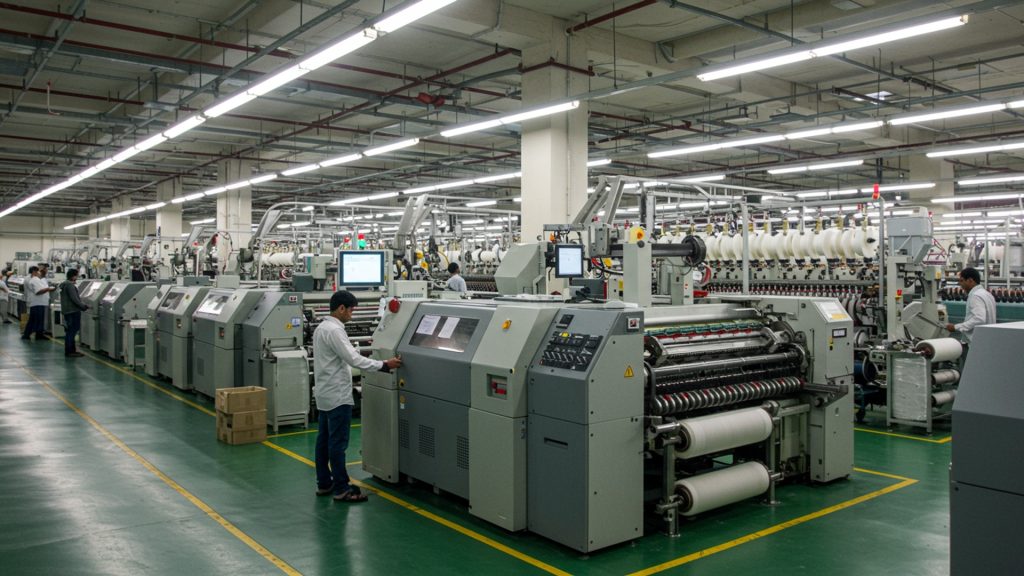Gujarat’s government today rolls out a bold new textile policy, immediately giving big new benefits to companies. This major move aims to make the state’s huge cloth-making industry much stronger, bringing in more money and creating many jobs. The new rules, now active, offer more help to businesses ready to build or expand their fabric factories throughout Gujarat. This policy is a game-changer, set to draw in large investments and cement Gujarat’s place as a world leader in textile production, boosting its economy for years to come.
New Rules for Textile Industry Support
The Gujarat government has recently released the detailed rules for financial help to its textile industry. These new rules come under the Gujarat Textile Policy 2024. The main idea behind these rules is to make the textile sector stronger, bring in more money from businesses. create many new jobs for people. This includes jobs in both villages and cities. The new rules mean that textile factories set up in industrial areas that the government has marked (called GIDC-notified areas) will now also be able to get government support. This change was asked for by groups like the Southern Gujarat Chamber of Commerce and Industry (SGCCI). The rules also cover large textile units that do everything from making thread to finished cloth. This is expected to give a big push to the state’s textile business.
Money Help for Businesses
The Gujarat Textile Policy 2024 offers various types of money help to textile companies. This is done to encourage new businesses and help existing ones grow. The aim is to make it easier for companies to invest in modern machines and expand their operations. One major part of this help is a Capital Subsidy. This means the government will give back a part of the money that companies invest in setting up new factories or buying big machines. This subsidy can be from 10% to 35% of the money spent on eligible fixed capital investment (eFCI). The most a company can get from this subsidy is Rs. 100 crore. The exact amount depends on where the factory is located, what type of textile work it does. how many people it employs. Another crucial help is the Interest Subsidy. This lowers the cost of borrowing money for textile units. Companies can get 5% to 7% of their interest payments covered for up to eight years. The exact percentage can be up to 2% to 3% of the eligible fixed capital investment each year, again depending on the area and type of work. This helps businesses by reducing the money they pay back on their loans. The policy also includes help with electricity costs, known as the Power Tariff Subsidy. Textile units that get electricity from power companies or use clean energy sources like solar power will get Rs. 1 off for each unit of electricity they use. This help lasts for five years from the time they start production. This shows the state’s plan to encourage cleaner ways of working and reduce harm to the environment. The table below shows a simple overview of some key financial benefits:
| Type of Help | What it Means | How Much Help |
|---|---|---|
| Capital Subsidy | Money back on new factory setup or big machine purchases | 10% to 35% of investment, up to Rs. 100 crore |
| Interest Subsidy | Lower cost on money borrowed for business | 5% to 7% of interest for up to 8 years |
| Power Tariff Subsidy | Lower cost on electricity use | Rs. 1 per unit for 5 years |
Help for Workers and Training
The new textile policy also puts a lot of focus on supporting workers and improving their skills. This is to make sure the industry has enough skilled people to grow and use new technologies. One type of support is Payroll Assistance. This means the government will help with paying workers’ salaries. Companies can get Rs. 2,000 to Rs. 5,000 per month for each worker. The policy gives more support for female workers, showing a focus on helping women in the workforce. The policy also gives special Assistance for Self-Help Groups (SHGs). These are groups of people, often women, who work together to earn money. The policy offers both salary help and training support for these groups. This inclusive approach aims to help more people, especially women, to become self-reliant and join the textile sector. Training programs are also planned to teach workers new and modern textile skills, making them more capable of operating advanced machines.
Why This New Policy Matters Now
The textile industry in Gujarat has faced many problems recently. The previous textile policy, which was launched in 2019, ended. for some time, there was no new policy. This made it hard for many companies. some even thought about moving to other states. The industry has been dealing with difficulties like problems in getting raw materials, changes in what customers want. money troubles around the world. There has also been a shortage of workers, both skilled and unskilled. For example, some spinning mills were working with only a small part of their needed workers, which affected their ability to make products. The cost of raw materials and labor has also gone up, making it tough for manufacturers to compete. Gujarat is a state that produces a lot of cotton. But, its ability to turn that cotton into thread and fabric has not grown as much. Much of the cotton grown in Gujarat was being sent to other states like Maharashtra and Tamil Nadu for processing. The new policy aims to fix this by supporting the entire process, from making thread to finished clothes. This new policy is seen as a way to solve these challenges. It aims to make the textile industry more stable and help it grow despite global changes. It wants to bring back investments and encourage companies to stay and expand in Gujarat.
What Industry Leaders Think
Leaders from the textile industry have welcomed the new policy. They have called it a “bold and full” plan. Many believe it will give Gujarat’s textile industry a strong advantage over others. They also expect it to attract new investments, help small and medium-sized businesses (MSMEs) grow. encourage new ideas and ways of working. For example, the Southern Gujarat Chamber of Commerce and Industry (SGCCI) had asked for textile units in city industrial zones to be included in the support plans. this has now been done. This shows that the government has listened to the needs of the industry. One industry leader stated,
“The enhanced incentives in capital and interest subsidies, payroll assistance and reduced power tariffs are expected to particularly benefit these labour-intensive sectors.”
This shows that the industry sees the direct benefits in terms of lower costs and more support for hiring people.
Looking to the Future
The new policy is expected to create a large number of jobs. Experts believe it will lead to more than 5 lakh new direct and indirect jobs. It is also aimed at bringing in a significant amount of business money, with targets for new investments in the textile sector. Part of this future growth includes the development of a large textile park under the PM MITRA plan. This park, to be built in Vansi in the Navsari district, will get a big investment of Rs. 3. 52 billion. Such parks will provide modern infrastructure for textile companies, helping to lower making costs and attract more businesses. The policy also focuses on making the textile industry more friendly to the environment. It encourages practices that reduce pollution and use resources wisely, aiming for “green growth.” By doing this, Gujarat wants its textile sector to be strong not just in India. also on the world stage, known for both quality and responsible production.

